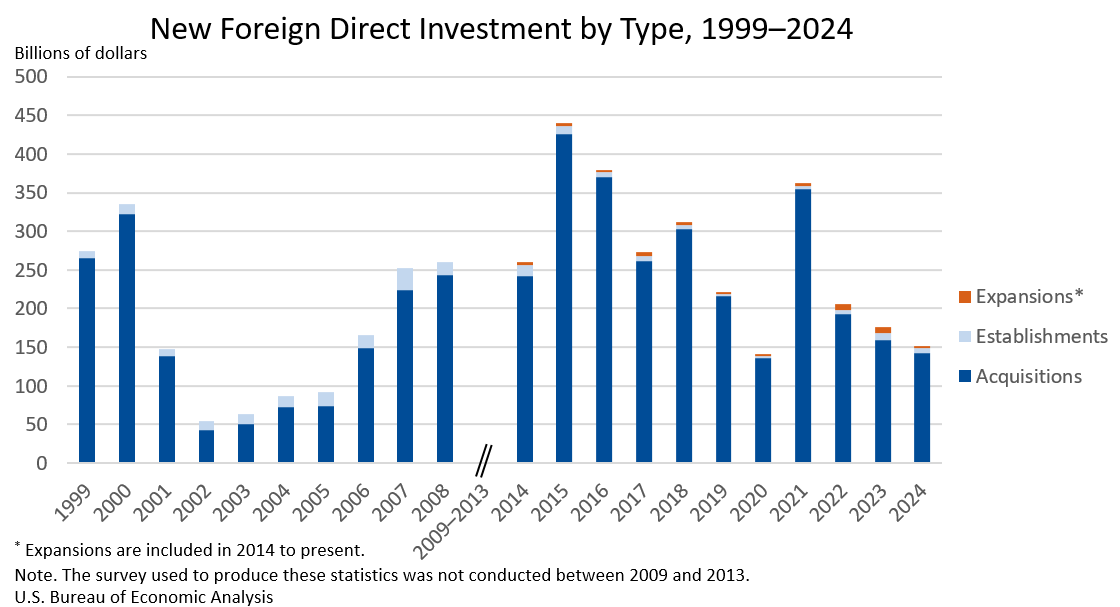Bureau of Economic Analysis
New Foreign Direct Investment in the United States, 2024
Expenditures by foreign direct investors to acquire, establish, or expand U.S. businesses totaled $151.0 billion in 2024, according to preliminary statistics released today by the U.S. Bureau of Economic Analysis. Expenditures decreased $24.9 billion, or 14.2 percent, from $176.0 billion (revised) in 2023 and were below the annual average of $277.2 billion for 2014–2023. As in previous years, acquisitions of existing U.S. businesses accounted for most of the expenditures.
Principal Federal Economic Indicators
Noteworthy
- 2025 News Release Schedule
- Innovation at BEA
- 2025 Annual Updates
- New! Services Trade Data for More Countries
- Data Tool: Trade in Value Added
- Distribution of State Personal Income
- Updated: RIMS II Regional Multipliers
- Arts and Culture
- Space Economy
- FDI Now in State BEARFACTS
- Quick Guide: Price Indexes
The Latest
BEA Updates Regional Economic Tool
Updated data are now available in BEA’s economic modeling tool used to estimate the impact of new projects or other changes in a region’s economy.
Personal Income and Outlays, June 2020
Personal income decreased 1.1 percent while consumer spending increased 5.6 percent in June, according to estimates released today by the Bureau of Economic Analysis.
Personal Income and Outlays, June 2020 and Annual Update
Personal income decreased 1.1 percent while consumer spending increased 5.6 percent in June, according to estimates released today by the Bureau of Economic Analysis.
Gross Domestic Product, Second Quarter 2020 (Advance Estimate) and Annual Update
Real gross domestic product (GDP) decreased at an annual rate of 32.9 percent in the second quarter of 2020, according to the “advance” estimate released by the Bureau of Economic Analysis. In the first quarter of 2020, real GDP decreased 5.0 percent. For more information, see the Technical Note.
Gross Domestic Product, 2nd Quarter 2020 (Advance Estimate) and Annual Update
Real gross domestic product (GDP) decreased at an annual rate of 32.9 percent in the second quarter of 2020, according to the “advance” estimate released by the Bureau of Economic Analysis. In the first quarter of 2020, real GDP decreased 5.0 percent.
Direct Investment by Country and Industry, 2019
The U.S. direct investment abroad position, or cumulative level of investment, increased $158.6 billion to $5.96 trillion at the end of 2019 from $5.80 trillion at the end of 2018, according to statistics released by the Bureau of Economic Analysis (BEA). The increase reflected a $95.7 billion increase in the position in Europe, primarily in the United Kingdom and the Netherlands. By industry, manufacturing affiliates accounted for most of…
Direct Investment by Country and Industry, 2019
The U.S. direct investment abroad position, or cumulative level of investment, increased $158.6 billion to $5.96 trillion at the end of 2019 from $5.80 trillion at the end of 2018, according to statistics released by the Bureau of Economic Analysis (BEA). The increase reflected a $95.7 billion increase in the position in Europe, primarily in the United Kingdom and the Netherlands. By industry, manufacturing affiliates accounted for most of the…
Annual Update of GDP Statistics Coming July 30
It’s time for BEA’s annual update of gross domestic product and related statistics. That means when we publish second quarter GDP numbers July 30, we’ll also update GDP estimates for the first quarter of 2020 and the previous five years.
Gross Domestic Product by State, 1st Quarter 2020
Real gross domestic product (GDP) decreased in all 50 states and the District of Columbia in the first quarter of 2020. The percent change in real GDP in the first quarter ranged from –1.3 percent in Nebraska to –8.2 percent in New York and Nevada.
Gross Domestic Product by State, 1st Quarter 2020
Real gross domestic product (GDP) decreased in all 50 states and the District of Columbia in the first quarter of 2020. The percent change in real GDP in the first quarter ranged from –1.3 percent in Nebraska to –8.2 percent in New York and Nevada.




